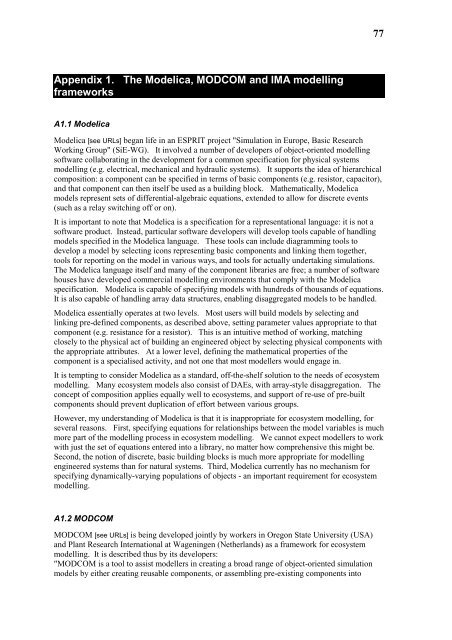pdf: 600KB - Potsdam Institute for Climate Impact Research
pdf: 600KB - Potsdam Institute for Climate Impact Research
pdf: 600KB - Potsdam Institute for Climate Impact Research
Create successful ePaper yourself
Turn your PDF publications into a flip-book with our unique Google optimized e-Paper software.
77<br />
Appendix 1. The Modelica, MODCOM and IMA modelling<br />
frameworks<br />
A1.1 Modelica<br />
Modelica [see URLs] began life in an ESPRIT project "Simulation in Europe, Basic <strong>Research</strong><br />
Working Group" (SiE-WG). It involved a number of developers of object-oriented modelling<br />
software collaborating in the development <strong>for</strong> a common specification <strong>for</strong> physical systems<br />
modelling (e.g. electrical, mechanical and hydraulic systems). It supports the idea of hierarchical<br />
composition: a component can be specified in terms of basic components (e.g. resistor, capacitor),<br />
and that component can then itself be used as a building block. Mathematically, Modelica<br />
models represent sets of differential-algebraic equations, extended to allow <strong>for</strong> discrete events<br />
(such as a relay switching off or on).<br />
It is important to note that Modelica is a specification <strong>for</strong> a representational language: it is not a<br />
software product. Instead, particular software developers will develop tools capable of handling<br />
models specified in the Modelica language. These tools can include diagramming tools to<br />
develop a model by selecting icons representing basic components and linking them together,<br />
tools <strong>for</strong> reporting on the model in various ways, and tools <strong>for</strong> actually undertaking simulations.<br />
The Modelica language itself and many of the component libraries are free; a number of software<br />
houses have developed commercial modelling environments that comply with the Modelica<br />
specification. Modelica is capable of specifying models with hundreds of thousands of equations.<br />
It is also capable of handling array data structures, enabling disaggregated models to be handled.<br />
Modelica essentially operates at two levels. Most users will build models by selecting and<br />
linking pre-defined components, as described above, setting parameter values appropriate to that<br />
component (e.g. resistance <strong>for</strong> a resistor). This is an intuitive method of working, matching<br />
closely to the physical act of building an engineered object by selecting physical components with<br />
the appropriate attributes. At a lower level, defining the mathematical properties of the<br />
component is a specialised activity, and not one that most modellers would engage in.<br />
It is tempting to consider Modelica as a standard, off-the-shelf solution to the needs of ecosystem<br />
modelling. Many ecosystem models also consist of DAEs, with array-style disaggregation. The<br />
concept of composition applies equally well to ecosystems, and support of re-use of pre-built<br />
components should prevent duplication of ef<strong>for</strong>t between various groups.<br />
However, my understanding of Modelica is that it is inappropriate <strong>for</strong> ecosystem modelling, <strong>for</strong><br />
several reasons. First, specifying equations <strong>for</strong> relationships between the model variables is much<br />
more part of the modelling process in ecosystem modelling. We cannot expect modellers to work<br />
with just the set of equations entered into a library, no matter how comprehensive this might be.<br />
Second, the notion of discrete, basic building blocks is much more appropriate <strong>for</strong> modelling<br />
engineered systems than <strong>for</strong> natural systems. Third, Modelica currently has no mechanism <strong>for</strong><br />
specifying dynamically-varying populations of objects - an important requirement <strong>for</strong> ecosystem<br />
modelling.<br />
A1.2 MODCOM<br />
MODCOM [see URLs] is being developed jointly by workers in Oregon State University (USA)<br />
and Plant <strong>Research</strong> International at Wageningen (Netherlands) as a framework <strong>for</strong> ecosystem<br />
modelling. It is described thus by its developers:<br />
"MODCOM is a tool to assist modellers in creating a broad range of object-oriented simulation<br />
models by either creating reusable components, or assembling pre-existing components into
















